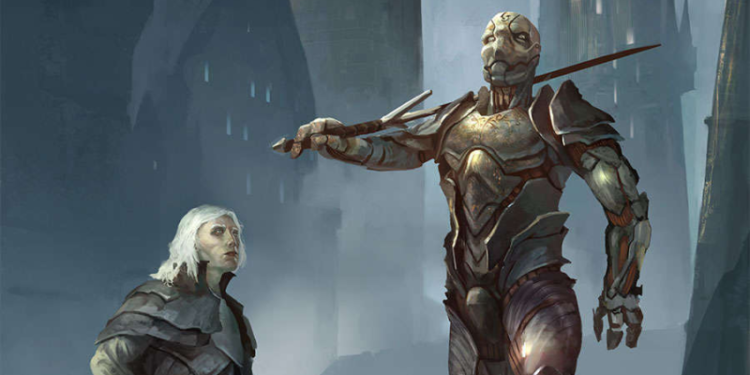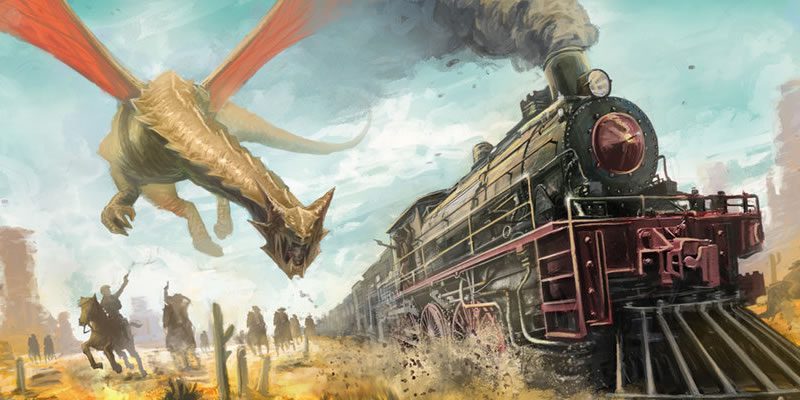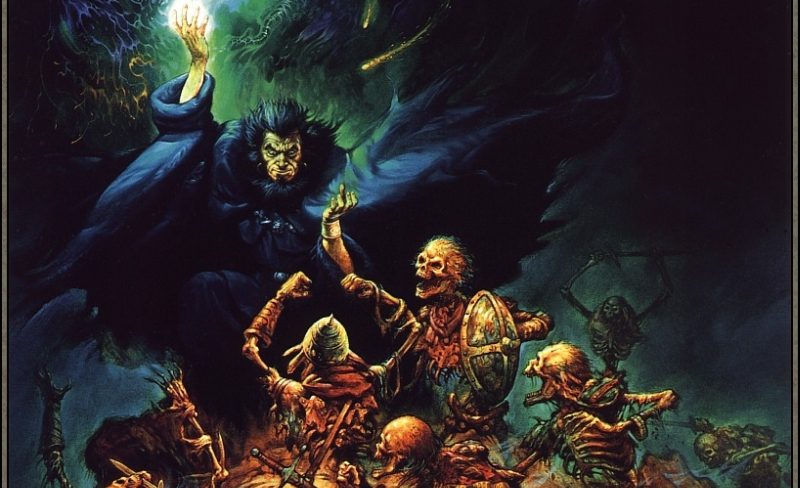
Last time in this breakdown series, I covered the back half of the new subclasses, and came away with a more positive outlook on Morgrave Miscellany as a whole. This time, we’re moving into the other areas of setting and rules content.
Barbarian – Fighter | Monk – Wizard | Cultures – Dragonmarks
Talenta
I’ve always loved the idea of Talenta’s dinosaur-riding halflings, though they haven’t featured in either of the Eberron campaigns I’ve played. In this section, there’s flavor text and some d8 tables to suggest further details for your Talenta halfling PC, followed by rules for a Talenta subrace of halflings and Talenta-specific weaponry.
The Talenta subrace is pretty straightforward:
- +1 Str. Halflings that get a Strength bonus amuse me, in a design-history sense, but it also works for me here.
- Born to Ride grants Animal Handling proficiency, and doubles your proficiency bonus to calm or domesticate beasts or dinosaurs (curiously redundant – all dinosaurs are Type: Beast).
- Talenta Weapons Training grants proficiency with the sharrash and the tangat, described below.
Simple and to the point. This gets the story across clearly. At most I’d want to see something more appended to Born to Ride, to keep mounts a relevant part of gameplay into the midgame (when they’re even usable), but that might be too much to ask one feature to solve. On the other hand, Talenta Weapons Training is about to show us that it’s a lot better than most racial weapons training features.
The stats on the sharrash and the tangat come next. They’re pretty weird, because let’s all remember that Small creatures like halflings usually have disadvantage with weapons with the heavy quality, and these both have that quality. Also, every reach weapon except the whip has the heavy quality, so the sharrash is a rare case of a halfling-friendly reach weapon.
The sharrash is, in essence, a lance you can trip people with – it has the same disadvantage against targets within 5 feet property that you know and love from lances, and also Police lyrics. It also has a tripping property – a Shove with reach – and while mounted, halflings deal +2d4 damage with it and don’t have to worry about its heavy property. 4d4 is a lot of base damage for a weapon – that’s an average of 10, or 3 points better than any other base weapon’s average damage. It’s a lot, in exchange for only being useful in scenes where you’re mounted.
The tangat doesn’t have any special attacks, but it’s basically a short-hafted glaive that halflings deal +2d4 damage with, for a total of 3d4 – just half a point more average damage than a greatsword, and so a phenomenal weapon to build a halfling warrior-type around. The Great Weapon fighting style is going to look real strange paired up with 3d4. Both of the weapons are unusual mechanical choices and I would love to know what other implementations they considered and discarded. On consideration, I don’t like the construction where just one race gets a passive, double-or-more damage bonus to a weapon, so that it’s useless to everyone else.
Shifters
This is quite a short section, with one table of backstory elements and three new shifter subraces. There were piles of shifter types in 3.x and… I think this was mostly handled with feats in 4e? Anyway, we get three more here.
Cliffwalk shifters are mountain-goat-like, which is sort of hard to get from the flavor text but obvious once you read the features. Goats climbing cliffs in improbable ways are awesome, so whatever.
- +1 Dex, +1 Int.
- Cloven Ascent grants a 30-ft climbing speed. Sure, no problem.
- Shifting Feature lets you ignore difficult terrain while shifting.
Looks fine to me. I’m not the person who’s knocking down anyone’s door to play a weregoat, but I know some of those people and I am delighted for them to have the content they want.
Swiftwing shifters are a conceptual intersection of flying and gliding creatures – the text seems to suggest birds, then shift to either bats or flying squirrels, while the mechanics point much more firmly to bats and flying squirrels. Werebat is not the craziest idea any of us have ever heard.
- +1 Cha, +1 Dex. Selling Cha as “because songbirds” is a weird move, but okay.
- Light as a Feather doubles your jump distance. The weird element here is that the flavor text specifically gets into how your bone marrow moves to become your wings.
- Shifting Feature grants a 30-ft flying speed, but with some additional requirements and costs in bonus actions. It’s fine, but it does make this much more for ranged combatants or exploration sequences than melee combat, since you fall if you don’t move 30 feet horizontally in that turn.
These are fine, maybe a little more tracking of distance moved than I’d like to see, but again I know people who would love this to pieces. (Hey, what’s up, Samantha?)
Truedive shifters represent dolphins, though I wouldn’t object to someone wanting to play one with an orca or otter theme.
- +1 Con, +1 Int.
- Swimmers Build grants a 30-ft swimming speed.
- Shifting Feature lets you breathe underwater. This seems on its face to move away from the “marine mammal” story, but one minute of water breathing really turns your total time underwater into (2 * (Con modifier +1) + 1) minutes – which is proportionately about right. It further grants resistance to cold and the pressure of the depths. One minute of resistance to the depths is probably not going to be enough to matter in many situations, though.
This is a reasonable and clear implementation of the concept. No real complaints. Of course I know people who would jump at the chance to play a were-otter. (As the kids say on the Twitters, “tag urself.”) I like that they have one for each of the three main alternate movement modes.
Tieflings
This is one of the areas where Eberron has to do some of the heaviest lifting to recontextualize a central piece of core 5e. Everything fits into Eberron, yes! But it doesn’t mean the same thing here, because devils don’t have the same role here as they do in most settings. The flavor text is of the typical high quality, and I’m fascinated with the introduction (or at least new-to-me) of the Venomous Demesne, a tiefling realm that traces its history back to Sarlona. On the mechanics side, we get seven new tiefling variants, many of them tied to Eberron’s planes.
Sakah are rakshasa tieflings, and now that I’ve written that phrase I (quite sincerely) expect it to be the next big fan art trend on Twitter and Pinterest. Make it happen.
- +2 Cha, +1 Dex.
- Vile Resistance is, obviously enough, poison resistance.
- Demonic Legacy grants primal savagery (from XGTE, and let me just say it’s weird to see this book integrate XGTE spells more fully than XGTE did), disguise self, and dust devil, with the typical 1st/3rd/5th
Yep, you’re part tiger demon, I’m sold.
Dolurrhi are death-and-despair tieflings. It’s not for me, but that’s all right. (“Don’t play characters who are depressed” is a personal rule that I took way too long to learn.)
- +2 Cha, +1 Wis.
- Maddening Resistance – yep, psychic resistance. All good.
- Legacy of Damnation grants vicious mockery, dissonant whispers, and crown of badness. People, stop handing out this spell as if you’re doing the player a favor. It is so bad.
Other than that one complaint, this is fine. Solid visual aesthetic in the flavor text, and if you’ve been carrying a grudge about WotC’s decision that tieflings are strictly diabolic rather than demonic or daemonic, well, Morgrave Miscellany has a different take on it.
Fernian tieflings are all fiery, with some obsidian thrown in for contrast. It’s a classic look, if not explicitly attested for D&D tieflings.
- +2 Cha, +1 Int.
- Hellish Resistance – yes, of course it’s fire resistance.
- Legacy of Flame grants control flame, searing smite, and flaming sphere. It’s, well, on-message.
Well… yep. That sure is a fire tiefling.
Kythri tieflings could look like anything, so take your copy of the original Planescape boxed set out of its climate-controlled case and have one of your librarians turn to the page with the random tiefling features table. (You don’t have any of those things? Me either. What a fool I was, in those heady days of 1994…)
- +2 Cha, +1 Int.
- Corrosive Resistance is self-explanatory.
- Legacy of Chaos grants infestation, chaos bolt, and blindness/deafness.
We’re still on good footing here.
Mabari tieflings are darkness-themed, and darkly beautiful. They sound a lot like Star Wars Zabrak to me, so good times.
- +2 Cha, +1 Wis
- Shadowy Resistance is, of course, necrotic resistance.
- Legacy of Night gives you minor illusion, charm person, and suggestion. I am honestly surprised not to see darkness on this list, because subtlety of spell selection is not what I expect here, but this is fine too.
Would play.
Risian tieflings are in the vein of Levistus, but it’s a whole plane of ice rather than an imprisoned archdevil.
- +2 Cha, +1 Con.
- Chilling Resistance… why don’t you tell me what you think this does?
- Legacy of Ice grants frostbite, armor of Agathys, and Snilloc’s snowball swarm.
Still more on-message tiefling action.
Shavaran tieflings are the most different of all the tiefling types here, since theirs is the plane of war and not a damage type.
- +2 Cha, +1 Str.
- Battle Hardened grants proficiency with light and medium armor, and with shields. This does mean the subrace does a lot less for some classes (…most classes…) than others.
- Legacy of War grants blade ward (almost completely useless unless you have a way to cast it as a bonus action), heroism, and shadow blade. Well, the last two spells are great.
This is the only one I’m not so impressed with. Aesthetically, still great – metal tiefling is (sorry) totally metal. Still, that’s a great hit rate for this many variations.
Dragonforged
And now we have an all-new concept that is exceptionally Eberron. Have you ever wanted to play an ultra-rare or even Chase rare creature? Dragonborn, but warforged is an amazing idea. Honestly, there are a ton of “nonhuman race but robot” concepts that are good fun.
- +2 Str, +1 Int.
- Warforged Resilience is unchanged from the warforged.
- Forged Scale grants an AC equal to 15 + your proficiency bonus. An AC that tops out at 21 (+ shield) is huge, especially with no disadvantage on Stealth checks. It’s not changeable, though, the way the baseline warforged is.
- Sentry’s Rest lets you go into a powered-down mode where you keep watch for 6 hours to take your long rest.
- Draconic Fission grants you three spells, again with the 1st/3rd/5th progression: gust, chromatic orb, and dragon’s breath.
Draconic Fission is the functional parallel to the subrace portions of other warforged, and makes them partial spellcasters and situationally great damage dealers. A draconic robot that blows out blasts of air and orbs or sprays of other damage flavors (but it’s all a spell they’re casting) seems really on-message to me, but I think that for most situations the Dragonforged are a noticeably more powerful than other warforged.
Dragonmarks
The next section is dragonmarks, here offered in feat form. Maybe you want a dragonmark that manifests later, maybe you don’t want to give up any race features. This offers both a Fledgling set of dragonmark feats that you can take to qualify for Greater Dragonmark feats, and a Siberys set of feats. As in 3.5, you can jump straight to the Siberys marks from no prior mark, or you can qualify by having bought a Greater dragonmark.
Since we’re talking about 26 feats, I’m not covering each one individually. The main thing I want to say is that the prerequisites are more involved here (Siberys marks require you to be 12th level) than you’d usually see in 5e feats, but still within reason. Also, Siberys mark features look pretty exciting, though several of them (like the Siberys Mark of Making) are telling a story that isn’t clear to me. I don’t just know why the Siberys Mark of Storm offers planar binding as one of its spells. That kind of thing. I’m okay with taking that as an unexpected thing, to be ruminated upon or investigated during play.
Next up are Greater Aberrant Dragonmarks, which offer a 2nd– and 3rd-level spell, as well as a panic-button defense feature that expends half of your Hit Dice for temporary immunity to damage that would take you down. There’s also a reference to “Child of Khyber,” which the text hasn’t explained yet. Looking ahead, I see that it’s a system to make aberrant dragonmarks replace race features the same way Wayfinder’s Guide to Eberron does with other types of dragonmarks. The defensive feature here looks like it might be a bit much, but the whole story of aberrant dragonmarks is the player courting trouble within the narrative.
Above Greater Aberrant Dragonmarks are Khyber Dragonmarks, the obvious parallel to Siberys marks. If they’ve ever been mentioned before now, I didn’t know about them, but I love that even long-time Eberron fans get previously unexplored ideas in XGTE and Morgrave Miscellany. They’re full-body marks, so even harder to conceal than typical aberrant marks. Good luck. On the other hand, they give you a 4th and 5th level spell from the sorcerer list, and you can spend hit dice to apply metamagic to them. This is the best terrible idea, and I mean that as praise.
The Mark of Death
An even bigger surprise comes next: the Mark of Death. This won’t mean anything if you aren’t invested in Eberron lore, but in short, all of the dragonmarks are quasi-genetic, and the Mark of Death was eradicated with extreme prejudice. Vol herself is the final bearer of the Mark of Death, and this is a huge deal in Eberron. But if you want some rules and lore suggestions for how a PC could bear the Mark of Death, well, here you go! I love the care that they gave the flavor text and DM guidance for this, one of the biggest enigmas of the setting.
The mechanics offered here run the full range of possibilities: a pseudo-subrace for elves, a fledgling mark, a greater mark, and a Siberys mark. First, the elf subrace:
- +1 Wis, +1 Cha. More than I’d usually expect for an elf subrace.
- Death’s Favor grants a d4 Intuition die for interaction with the undead.
- Unliving Bond lets you communicate telepathically with the undead, and grant them advantage on attacks against creatures adjacent to you.
That’s not incredibly useful for a starting dragonmark, which is probably why there’s a second ability score point.
The Fledgling Mark of Death proposes that you have to be an elf or a dragonborn to qualify, and have no other dragonmark.
- +1 Cha
- Death’s Favor, as above.
- You learn spare the dying.
On its own merits – like many fledgling marks – it’s on the low end of feat power, but you’re buying into both story and future progression. We mostly don’t want to see 3.x-style “this feat is bad but you have to buy it as a prerequisite for later good feats,” but I’ll grant that they didn’t have a ton of space to make fledgling feats impressive.
The Greater Mark of Death follows on either the subrace or the fledgling mark, and requires you to be 8th level or higher.
- +1 Cha
- +1 die size to your Intuition die (so presumably you’re up to a d6).
- You can cast gentle repose and speak with dead as rituals. You can cast spirit guardians once, and at 15th level you can cast danse macabre (from XGTE) once.
This is fine, though it’s not yet a mark to terrify Aerenal into genocide.
The Siberys Mark of Death is the penultimate expression of the Mark of Death. (The Apex Mark of Death is strictly a lore element, and I wouldn’t expect any official presentation of what it could or should do, ever. It moves at the speed of plot.)
- +1 Cha. A third feat granting a Cha bonus is a reason to offer an alternative, in my view. I don’t love seeing feats require pre-planning of stats from 1st level to avoid wasting something as valuable as an ability score point.
- The persuasiveness of the Mark of Death expands to work on dragons and dragonmarked creatures.
- You can cast revivify, speak with dead, and spirit guardians.
Well, that’s stronger than just about any other feat in the game, prerequisites notwithstanding. I think you’ve got to approach it with the understanding that NPCs with the Mark of Death aren’t necessarily bound by all of the same rules as PCs, because again, this isn’t so mighty as to remotely justify the Aerenal’s actions.
Conclusion
That’s where I’m leaving it for this week. I’m hoping that Part Four can get us to the end of Morgrave Miscellany, but the fact of the matter is that we still have a lot of content left to go – the aberrant subraces for Children of Khyber, a collection of feats, new backgrounds, and so on.
At this stage of my review, I’m very impressed with the book’s contents. Part One was a bit rocky, Part Two was very strong with just a few quibbles, and Part Three is not only mechanically sound, but exploring and expanding corners of Eberron lore we’ve never seen before.



